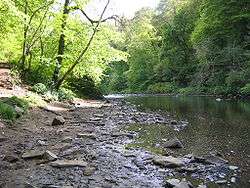Avon Water
Avon Water, also known locally as the River Avon, is a 24-mile-long (39 km) river in Scotland, and a tributary of the River Clyde.
| Avon Water | |
|---|---|
 The Avon Water in Chatelherault Country Park, Hamilton. | |
| Location | |
| Country | United Kingdom, Scotland |
| Region | South Lanarkshire |
| Physical characteristics | |
| Source | |
| • location | Distinkhorn Hill[1] |
| Mouth | |
• location | Hamilton |
| Length | 39 km (24 mi) |
Course
The Avon Water rises in the hills on the boundary between East Ayrshire and South Lanarkshire, close to the head of the Irvine Water. The river flows in a north easterly direction, following the A71 road past Drumclog, and running to the south of Strathaven, where the river enters a more pronounced valley. The Avon flows between the village of Glassford, and Stonehouse to the south, before merging with the smaller Cander Water just south of Larkhall. The river then skirts the west side of Larkhall in a deepening gorge, crossed by the disused Larkhall railway viaduct, built in 1904 for the Caledonian Railway.[2][3]
Beyond this the gorge is part of Chatelherault Country Park, to the south of Hamilton. There are several public footpaths along this section of the gorge, although the area was once the preserve of the Duke of Hamilton, forming the hunting and pleasure grounds of the Dukes' former home, Hamilton Palace. Many features of this period remain in the park, including the Duke's Bridge which crosses the gorge. Older structures along the gorge include the ruins of Cadzow Castle, started in the 13th century, and the Cadzow Oaks, a group of oak trees, some of which are over 600 years old.
The river bends to the east at the end of the gorge, flowing beneath three bridges: one carrying the Argyle railway line, one carrying the A72 road, and the Old Avon Bridge, now a footbridge. The Avon Water flows north beneath the M74 motorway, merging into the Clyde between Hamilton and Motherwell, beside Junction 6 of the M74.
Avon River, New Zealand
The Avon River which flows through the centre of the city Christchurch, New Zealand was named Avon at the request of the pioneering Deans brothers to commemorate this Scottish Avon, which rises in the Ayrshire hills near what was their grandfathers' farm,[4] Over Auchentiber.[5]
Etymology
The name Avon is derived from the Brittonic āβonā- (from āβ, "moving water", with the suffix –onā-),[6] the word ancestral to Welsh afon, meaning "a river".[6]
References
- "Avon Water". Gazetteer for Scotland. Retrieved 10 December 2017.
- McQuillan, Rebecca (6 April 2013). "Life after Beeching". Sunday Herald. Retrieved 10 December 2017.
- "Larkhall Viaduct". Gazetteer for Scotland. Retrieved 10 December 2017.
- Christchurch New Zealand
- Hight, James; Straubel, C. R. (1957). A History of Canterbury : to 1854. I. Christchurch: Whitcombe and Tombs Ltd. p. 121.
- James, Alan. "A Guide to the Place-Name Evidence" (PDF). SPNS - The Brittonic Language in the Old North. Archived from the original (PDF) on 13 August 2017. Retrieved 25 November 2018.